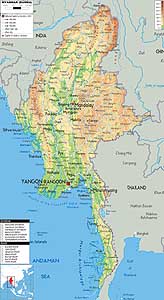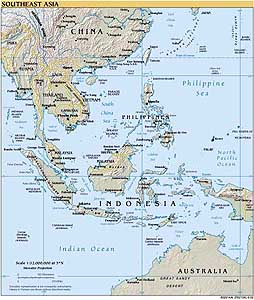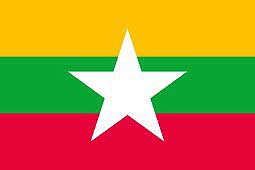-
- Myanmar Map
|
-
- Map
of Southeast Asia
|
|
-
|
- latest picture:
January 21, 2017
|
-
-
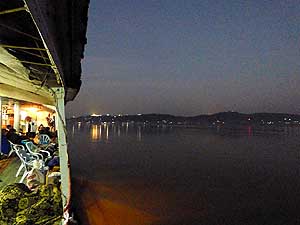
|
-
-
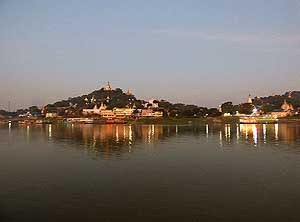
|
-
-
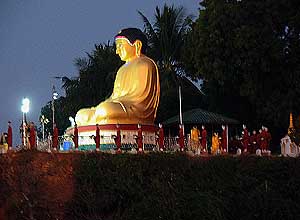
|
-
262 1/18/2017; 5.30am: Our ”Government
- Boat”
leaves the IWT Gawain Jetty in Mandalay
- (C 21.97020/96.05609). It will
sail with us during 14
- hours for US$29.60 (= 2 people) on the mighty
- Irrawaddy River to Bagan. It’s still night. Only a
- few lights are
visible on the shore of Sagaing
|
-
263 It dawns slowly. On the western –
- later the northern – hilly riverbank we can
- recognize some pagodas rising skywards
- around Sagaing Hill
|
-
264 The first rays of the
sun are catching
- a golden Buddha in Sagaing – a special
- eyecatcher in
the early morning hour
|
-
|
-
-
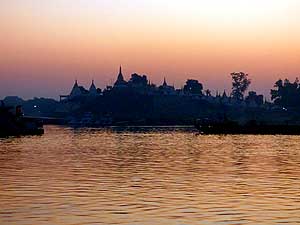
|
-
-
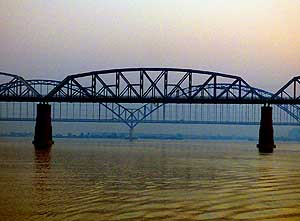
|
-
-
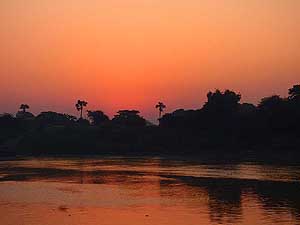
|
-
265 The sunrise announces itself with a
- soft red
and spreads a mystical atmosphere.
- Once more the “Sone-U Pone Nya Shin
- Pagoda” on the top of Sagaing Hill
|
-
266 The two bridges over the Irrawaddy River
- in
Mandalay; the first is the longer Inwa railway/
- road combination (3'948
ft.) [1’203m] from
- 1934, while the newer (2008) Yadanabon road
- bridge
(3'694 ft.) [1’126m] is visible behind it
|
-
267 The skies glow at
sunrise (6.50am)
- and reflect in the calm surface of the mighty
- Irrawaddy River, the biggest river of
- Myanmar (1'373 miles long) [2’210km]
|
-
|
-
-
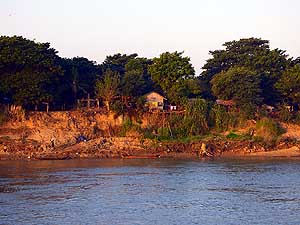
|
-
-
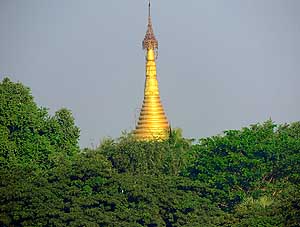
|
-
-
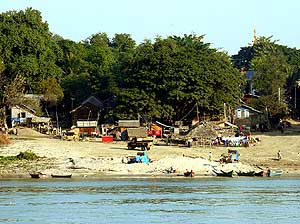
|
-
268 A dwelling of palm leaves nestles
- between the
red earth bankside
- and the stately trees
|
-
269 A picture that characterizes unmistakably
- Myanmar, be it on the Irrawaddy River bank,
- be it in towns or in the countryside: Golden
- pagodas are rising up everywhere
|
-
270 A small settlement of
modest huts snuggling
- into the shade of trees: It must be somehow
- connected with the road network. Why a pickup
- truck would otherwise be
parked there?
|
-
|
-
-
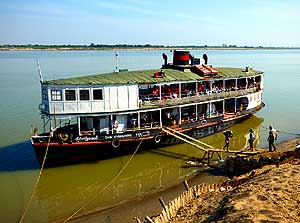
|
-
-

|
-
-
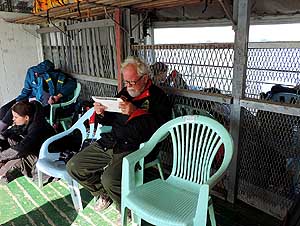
|
-
271 Our supply boat “Tain Kyohsaung” goes
- ashore to unload and load. Those moments are
- the most interesting for us as they reveal still
- authentic live of a country that has been cut
- off from the rest of the world for decades
|
-
272 View into the clean engine
- compartment of our rather age-worn
- vessel, manufactured 1955 in Japan
|
-
273 Emil plays with his tablet
and is
- checking our current location with GPS.
- At many places was telephone network
- reception (2G), thus also slow internet
|
-
|
-
-
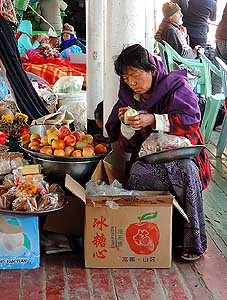
|
-
-
-
-
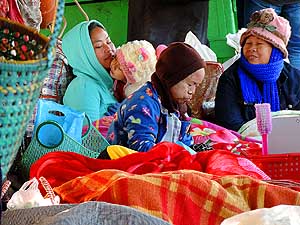
|
-
-
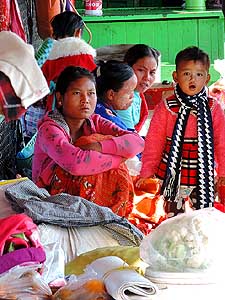
|
-
274 The only vendor on board sells snacks,
- sweets, bananas and apples. At the board
- kitchen there is hot coffee and tea and
- simple rice and noodle dishes
|
-
275 Contrary to us tourists who are sitting
- on chairs, locals are lying or sitting on the
- floor wrapped up in blankets. During the
- first morning hours it is still bitingly cold …..
|
-
276 ….. they are not much interested
- in the passing-by scenery,
- but kill the time gossiping
|
-
|
-
-
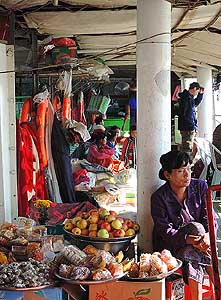
|
-
-
-
-
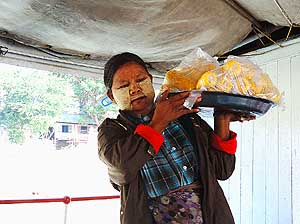
|
-
-
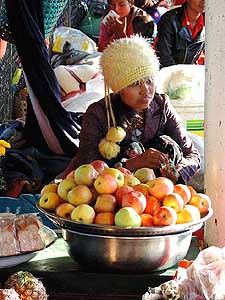
|
-
277 From our seats we have a good
- view over the only “exotic corner”
- with the locals
|
-
278
At a stop, a vendor comes on
- board to sell food. She wears the
- typical Myanmese sunscreen make-up,
- called “Thanaka”
|
-
279 A girl is huddling in front of the apple
- bowl. She still wears her woolen beanie. It is
- warming up only slowly. While there are only
- around a dozen locals on board, we count
- 40 western backpackers and tourists
|
-
|
-
-
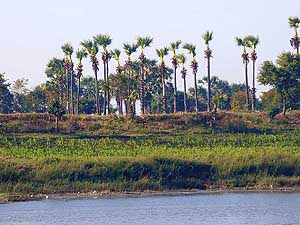
|
-
-
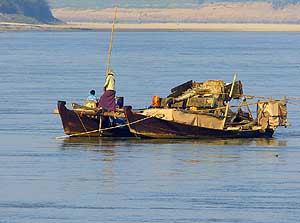
|
-
-
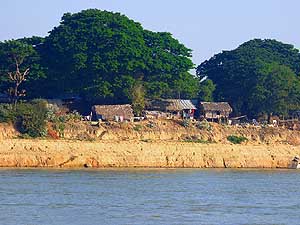
|
-
280 A grove of palms with planting
- comes into
sight. The scenery at the river
- bank of the Irrawaddy changes
constantly
|
-
281 A gold dredging pump on a boat
- on the Irrawaddy River. The people of
- the Irrawaddy (Kachin, Shan, Bamar)
- have been gold panning for centuries
|
-
282 A few huts on the
shore, where its peoples
- live a modest life. It recalls our 21 days' adventure
- in March 1991 on the River
Zaire in Africa (now
- DR Congo) and our river trip on the Madeira
- River in the Amazon in
Brazil in April 1988
|
-
|
-
-
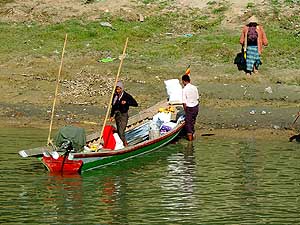
|
-
-
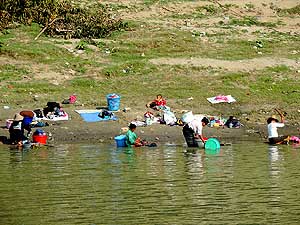
|
-
-
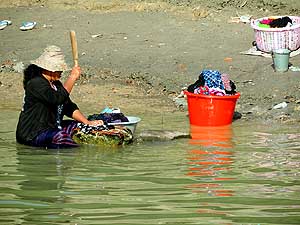
|
-
283 Ready for the boat trip –
- just waiting for the last passenger
|
-
284 The people of the Irrawaddy depend on
- the river that flows (1'373 miles long) [2’210km]
- from the far north across the country southwards
- into the Andaman Sea. Here laundry is made …..
|
-
285 ….. and clothes are
tapped on stones
|
-
|
-
-
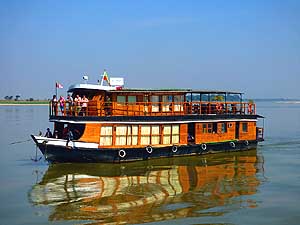
|
-
-
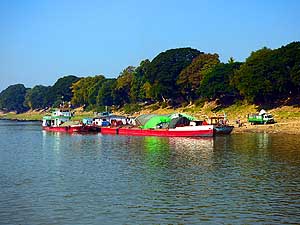
|
-
-
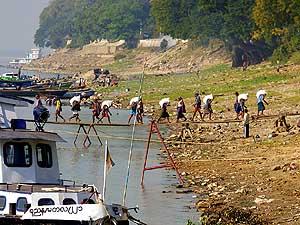
|
-
286 A sterile tourist boat overtakes us. Tariff:
- $32 to 52 p.P., while we on the government
- boat pay only $15 p.P. They
do not land any-
- where, drive faster than us and the passengers
- hardly
experience the exotic activity ashore
|
-
287 Cargo boats are moored at the river
- shore
loading goods onto small trucks.
- The Irrawaddy River is often the only
- connection to the outside world
- for the Irrawaddy people
|
-
288 Porters with heavy bags
balance
- over small wooden planks to the shore
|
-
|
-
-
-
-

|
-
-
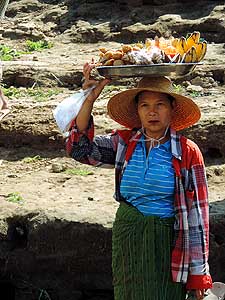
|
-
-
-
-
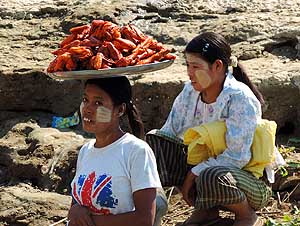
|
-
289
Vendors are waiting to be let onto
- our ferry, hoping to sell there some
- fruits or precooked food …..
|
-
290 ….. this Burmese carries a
- bowl with fruits on her head …..
|
-
291
….. while this girl sells fried chicken parts
|
-
|
-
-
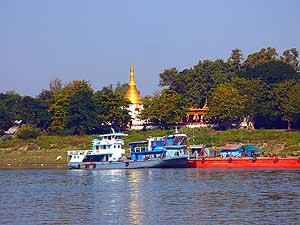
|
-
-
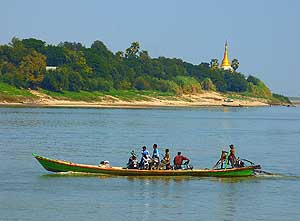
|
-
-
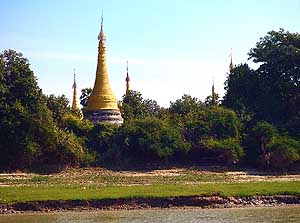
|
-
292 Another stunning colorful picture,
- which fascinates us
|
-
293 Everything is transported on the
- Irrawaddy
River – even bicycles. Because
- there are no bridges between Mandalay an
- Bagan (84 miles by road [135km]), everything
- has to be ferried by all sorts of floating means
|
-
294 The banks of the
Irrawaddy
- are dotted with golden gleaming
- stupas, temples and pagodas
|
-
|
-
-
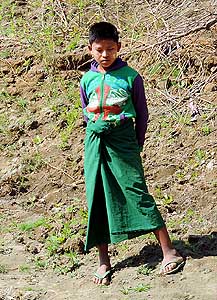
|
-
-
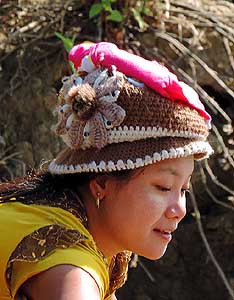
|
-
-
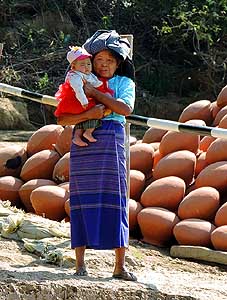
|
-
295
A youngster in his traditional
- Longyi is watching life on the
river
|
-
296 The young girl is wearing
- an especially decorative beanie
|
-
297
Grandmother and granddaughter are
- watching from the shore the
activity on our boat
|
-
|
-
-
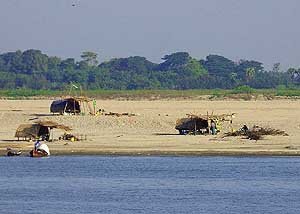
|
-
-
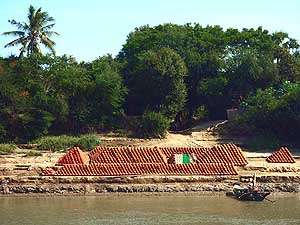
|
-
-
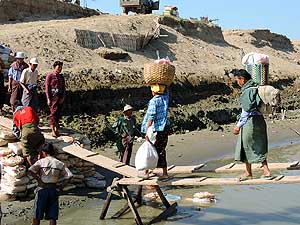
|
-
298 Fishermen built some modest sun
- protecting shelters on a broad sandbank.
- Possibly it works also for housing
|
-
299 At a village carefully piled up clay
- jugs are waiting to be transported.
- They will be sold on markets
|
-
300 Passengers leave our boat
with luggage
- on their head, on their shoulder and in their
- hand over the wooden planks pulled out
- and pulled in by the ship’s crew
|
-
|
-
-
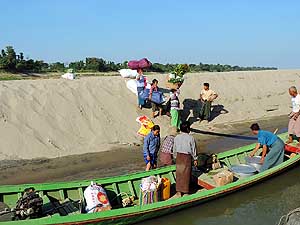
|
-
-
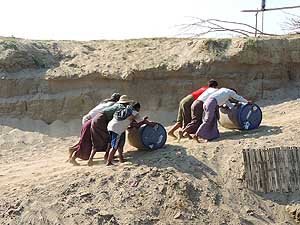
|
-
-
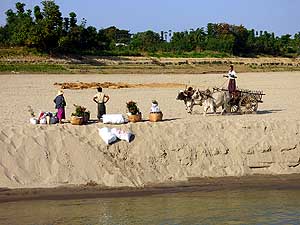
|
-
301 Passengers who left our boat but live
- on a different place or on the other side
- of the river carry their baggage to the
- already waiting small ”feeder vessel”
|
-
302 Everything has to be transported
- to isolated communities, also petrol barrels.
- It needs strong men to pull them up a sandbar
|
-
303 Everything is organized,
also the taxi:
- A bullock cart is on the scene to transport
- residents and goods to their final destination
|
-
|
-
-
-
-
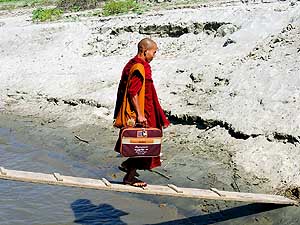
|
-
-
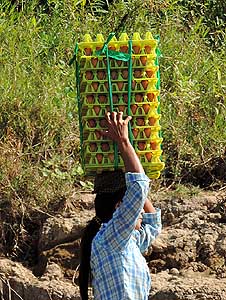
|
-
-
-
-
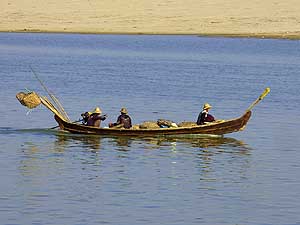
|
-
304
Also a monk is leaving our boat
|
-
305 A delicate undertaking: This Burmese
- is climbing up a steep hill, balancing 10 layers
- of raw eggs on her head – likely about
- 40 pounds [18kg]. If it only goes well!
|
-
306 A fishing boat is floating peacefully
- on the water. Memories of Africa pop
up!
- (check picture #282)
|
-
|
-
-
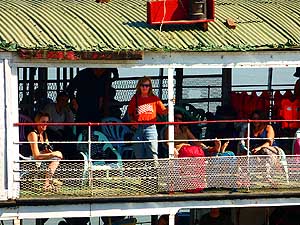
|
-
-
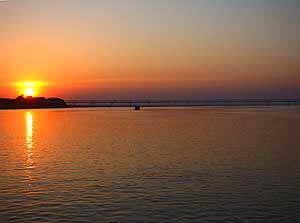
|
-
-
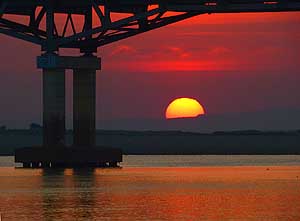
|
-
307 Liliana’s preferred spot on our river
- boat. She loves to watch the exotic happening
- at the landing stages and to take pictures. The
- boat stopped eight times and each time it was
- differently exciting
|
-
308 The Irrawaddy-Pakokku bridge is visible
- at sunset. We passed 88 miles [142km]
and
- 13 hours earlier at sunrise the previous
road bridge
- at Sagaing/Mandalay. It’s
now still 13 miles
- [21km] to Nyaung-U,
the landing stage for Bagan
|
-
309 The golden ball of the
sun sets
- behind the bridge. The impressing 14-hour
- journey from
Mandalay to Bagan on the
- Irrawaddy comes to an end although
- the river is navigable to the mouth
|
-
|
-
-
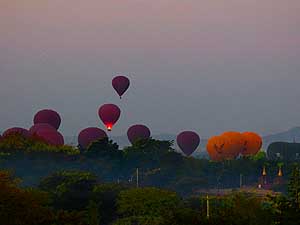
|
-
-
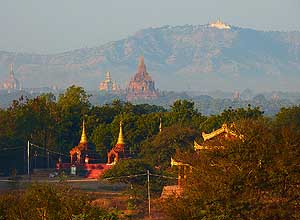
|
-
-
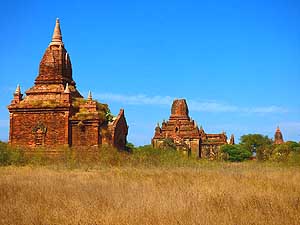
|
-
310 Early morning hot air balloons with
- tourists
are silently rising skywards to watch
- the sunrise over Bagan‘s
uncountable shrines
- and stupas. A 45 to 60 minute adventure
- cost more
than US$380 p.P.!
|
-
311 The magic of Bagan: From the terrace
- of our
“Sky View Hotel” we enjoy the sight
- over the temples as the first rays
of sun
- make the pagodas gleam. In the background
- Mount Popa, beeline
27 miles [43km]
|
-
312 Abandoned overgrown
temple ruins in
- the steppe-like landscape of Bagan invite to be
- explored. Tha Gyar Hit Phaya, north of Bagan–
- Nyaung-U road. The top of
the right temple
- collapsed during the latest earthquake on
- 8/24/2016 (C 21.18410/94.88190)
|
-
|
-
-
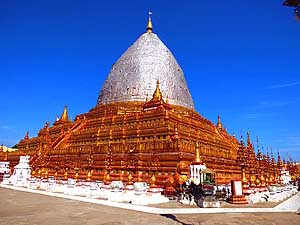
|
-
-
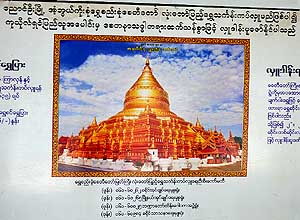
|
-
-
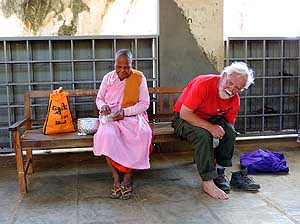
|
-
313 The Schwezigon Pagoda in Nyaung-U
- with its
bell-shaped stupa is the mother of all
- Bagan pagodas. It was built by
King Anawrahta
- in search of a dignified location to host a bone
- of
Buddha. When his white elephant carrying
- the relict kneeled down at
this place, it was
- considered as a divine sign (C 21.19534/94.89390)
|
-
314 This is how the Schwezigon Pagoda
- looked before its dome was covered due
- to the damage caused by the earthquake in
- August 2016. The quake with a magnitude
- of 6.8 damaged at least 185 pagodas
|
-
315 After his temple visit,
Emil sits
- down on a bench next to a Buddhist
- nun to put his socks and shoes back.
- Holy places are only allowed to enter
- barefoot – recommendable: flip-flops
|
-
|
-
-
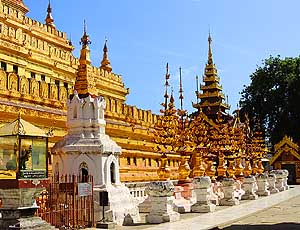
|
-
-
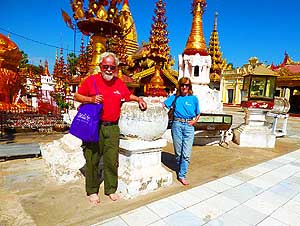
|
-
-
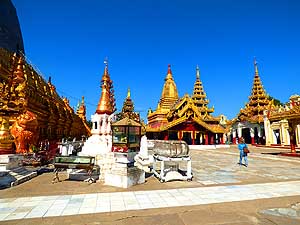
|
-
316 Trees of golden flowers adorn parts
- of the Schwezigon Pagoda (downright).
- They add to its special beauty
|
-
317 The two of us in the inner courtyard of
- the Schwezigon Pagoda – another one of
- the important pilgrimage sites of Myanmar
|
-
318 Liliana is admiring
the richness and beauty of
- the golden shimmering Schwezigon Pagoda. It
sits
- on the right hand side on three tall square terraces
|
-
|
-
-
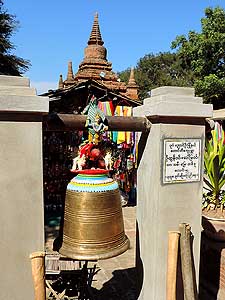
|
-
-
-
-
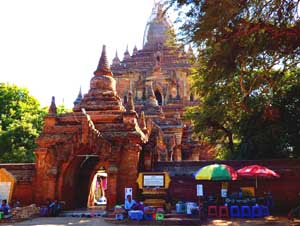
|
-
-
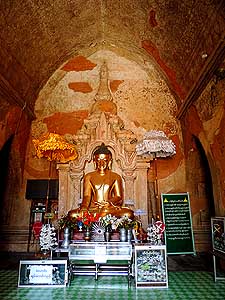
|
-
319
Near the entrance of the Htilominlo
- Temple a huge bell
attracts our attention
|
-
320
The Buddhist Htilominlo Temple was
- built in 1218 from
brickwork. It is 151 ft.
- [46m] tall and counts to the big structures
in
- Bagan (C 21.17858/94.87930). It also suffered
- damages due to the
2016 earthquake
|
-
321
Buddha shrine at the Htilominlo
- Temple. The array of styles of
- Burmese Buddhas is strikingly wide
|
-
|
-
-
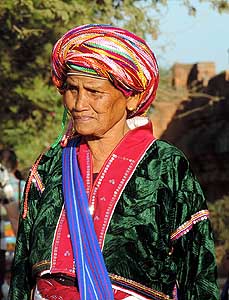
|
-
-
-
-
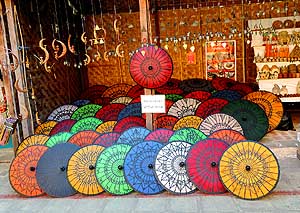
|
-
-
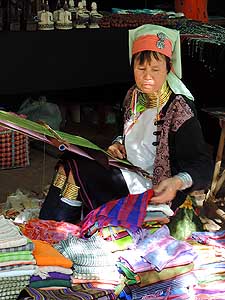
|
-
322
To which ethnic group might this
- woman with her beautiful
turban belong?
- She’s probably from the Pao tribe.
- Myanmar is a real treasure box of colorful
- ethnic groups. Some fight still a war
|
-
323 Beautiful traditional parasols
- are part of the many souvenirs
- sold at shops near the temples
|
-
324
A woman from the Padaung tribe –
- also called Kayan Lahwi – which
is a sub-
- group of the “Red Karen” (Karenni people),
- but named also “Long Neck Karen”,
- is working on her weaving loom
|
-
|
-
-
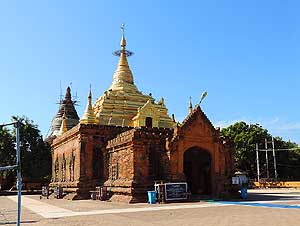
|
-
-
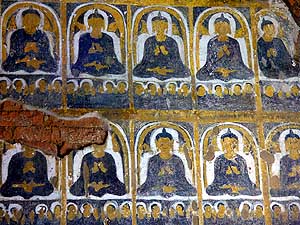
|
-
-
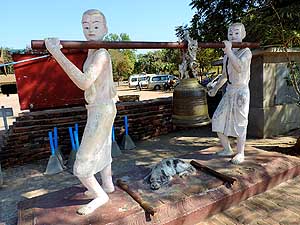
|
-
325 Built in a different architecture is
- Alodawpye Phaya Temple
- (C 21.17686/94.88261) …..
|
-
326 ….. its wall paintings are
- still quite well preserved …..
|
-
327 ….. in the temple compound
two
- dazzling white monk figures carrying a big
- bell on a long pole are eye-catching
|
-
|
-
-
-
-
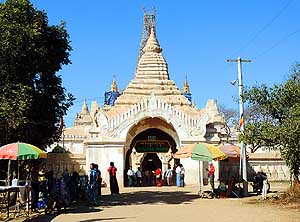
|
-
-
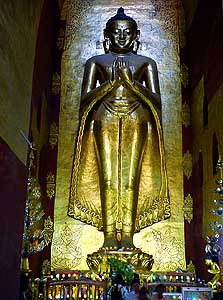
|
-
-
-
-
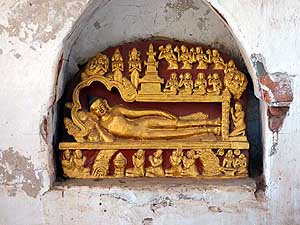
|
-
328
Main entrance to the 164 ft. [50m] tall
- Ananda Phaya Temple.
Built in the shape of
- a cross with four entry halls, it is considered
- as Bagan’s most beautiful. It was built bet-
- ween 1091 and 1105 (C
21.17084/94.86769)
|
-
329
One of the four Buddhas placed
- in all four cardinal directions
at the
- Ananda temple. Also this temple’s top has
- been damaged during the 2016 quake
|
-
330
One of the dozens of niches in
- the Ananda Temple showing a master-
- piece of a scene of Buddha’s life
|
-
|
-
-
-
-
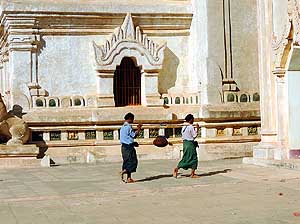
|
-
-
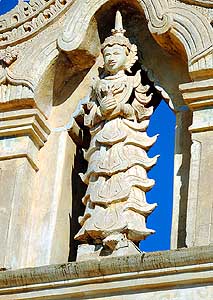
|
-
-
-
-
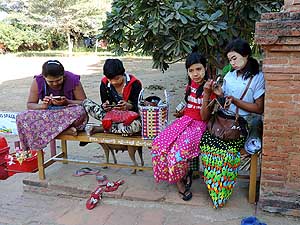
|
-
331
Two porters are carrying a bowl into
- the interior of the Ananda Temple which is
- constructed in Indian style architecture
|
-
332
An especially beautiful example of
- a Buddha statue carved from
stone in an
- outer niche of the Ananda Temple, the
- most important
shrine in Bagan
|
-
333 Burmese ladies at a temple complex
- are busy counting money and playing with
- their ubiquitous smart phones
|
-
|
-
-
-
-
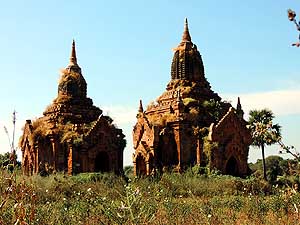
|
-
-
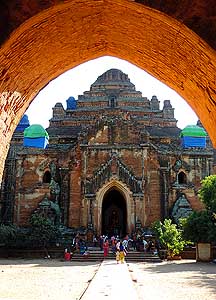
|
-
-
-
-
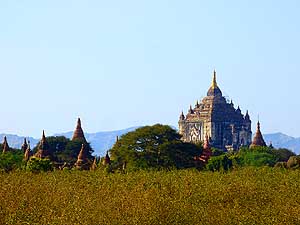
|
-
334
Abandoned and forgotten temples in
- Bagan’s steppe – altogether
about 2’200
|
-
335
The Dhammayangyi Temple southeast
- of Old Bagan sits in an attractive garden-like
- compound and is outstanding in its shape of
- a pyramid (C 21.16206/94.87291)
|
-
336
Wherever we look, temples are
- looming everywhere in Bagan’s
landscape.
- On the right-hand side in the background
- the 201 ft. [61m]
tall Thatbyinnyu Temple
|
-
|
-
-
-
-
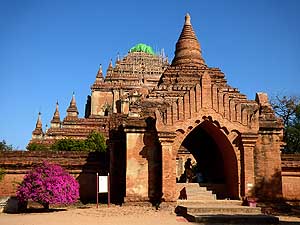
|
-
-
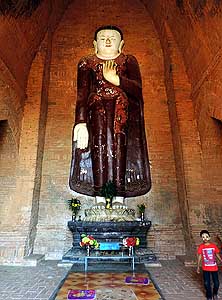
|
-
-
-
-
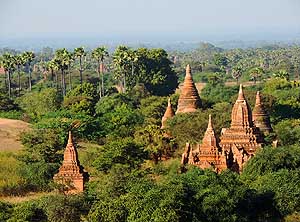
|
-
337
The Sulamani Temple was constructed
- in 1183 under the reign of
King Narapatisithu.
- Especially attractive are its stucco facades.
- Unfortunately it lost also its whole top during
- the August 2016
earthquake (C 21.16492/94.88133)
|
-
338
An immense Buddha statue
- at the Sulamani Temple
|
-
339
Forgotten ancient temples rising in the
- Bagan plains. View
from the Sulamani Temple.
- Besides the Shwesandaw Paya
(pic #344) and the
- Pyathada Paya (C 21.15830/94.88932)
Temples, one
- of the few which
still are allowed to be climbed
|
-
|
-
-
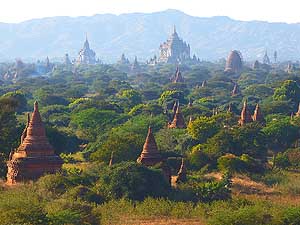
|
-
-
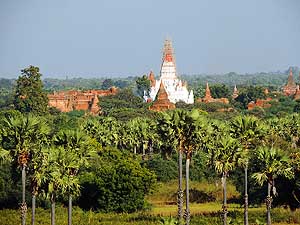
|
-
-
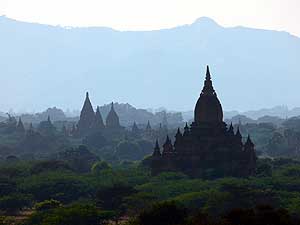
|
- In each direction, the plains around Bagan are dotted with temples
and monuments (view from the Sulamani Temple)
|
-
340 Northwest
|
-
341 East
|
-
342 South
|
-
|
-
-
-
-
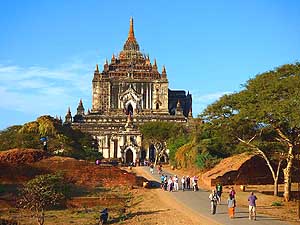
|
-
-
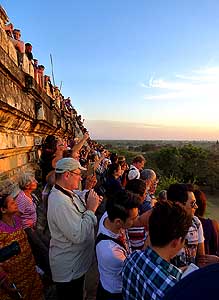
|
-
-
-
-
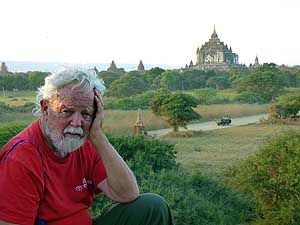
|
-
343
The Thatbyinnyu Temple
- (C 21.16876/94.86300) northwesterly of
- the Dhammayangyi Temple (pic #335)
|
-
344
Not anymore an insider tip! The
- cameras are ready. Hordes of
tourists have
- gathered at the platforms of the Shwesandaw
- Pagoda (C
21.16377/94.86608) for sunset and
- still more are arriving …..
|
-
345
….. no wonder that Emil’s face does
- not look very happy,
because in the crowd
- of tourists the ‘special experience’ is lost.
- In
the background the Thatbyinnyu
- Temple (pic #343) can be seen
|
-
|
-
-

|
-
-
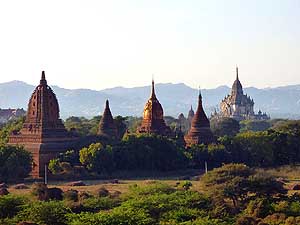
|
-
-
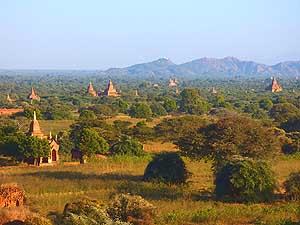
|
- View from Shwesandaw-Pagoda: Bagan, the capital city of the
ancient Burmese kingdom looks quite surreal when the setting sun puts
its glow
- over the temples scattered across the plain. On an area of
barely 15½ mi² [40km²] there are still about 2’200 temples and
monuments in Bagan
|
-
346 East
|
-
347 Nor'-nor'-west
|
-
348 Southeast
|
-
|
-
-
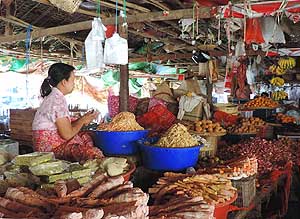
|
-
-
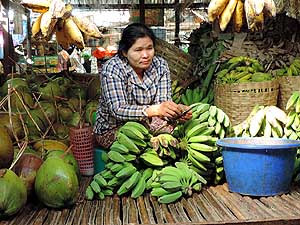
|
-
-
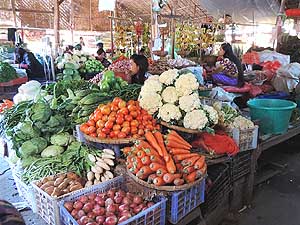
|
-
349 The market woman in Nyaung-U
- (Bagan) is grating a kind of vegetable
- bulb into a bowl
|
-
350 Sitting behind her heap of bananas
and
- besides some coconuts, the market woman in
- Nyaung-U (Bagan) is waiting
for customers
|
-
351 The range of
vegetables at Nyaung-U’s
- market is ample: Cauliflower, tomatoes, zucchini,
- carrots, celery, cabbage, potatoes, beans,
- onions – everything was carried freshly from
- her village early morning by the market woman
|
-
|
-
-
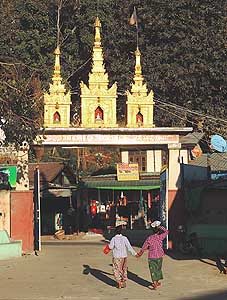
|
-
-
-
-
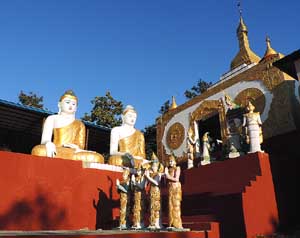
|
-
-

|
-
352
Each of the three golden shining turrets
- in an entrance at Popa Village hosts a
Buddha
- statue in a small
niche
|
-
353
The pagoda at the base of Mount
- Popa delights with its richly ornamented
- golden Buddha figures …..
|
-
354 ….. and with its free standing
- Buddha under a baldachin
|
-
|
-
-
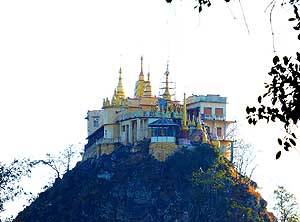
|
-
-
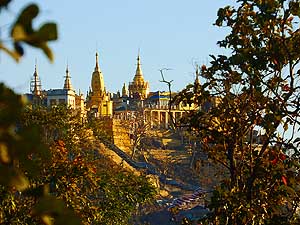
|
-
-
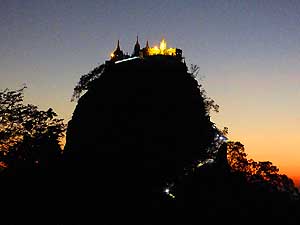
|
-
355 The actual mountain “Mount Popa”
- (mountain of
flowers) is a 4’981 ft. [1’518m]
- high inactive volcano, which erupted
the last
- time 250’000 years ago. 2 miles [3½km] west
- of it rises the
2’156 ft. [657m] high volcanic
- plug “Taung Kalat” with the monastery
and
- pilgrimage site “Mt. Popa” out of the steppe,
- about 30 miles
[50km] from Nyaung-U (Bagan)
|
-
356 777 steps lead to the “Mount Popa”
- monastery
with the “Tuyi n Taung” Pagoda.
- Being a Buddhist sacred place, it is
not allowed
- to set foot with shoes in the whole area.
- The steps
however are littered with monkey
- poo. The relatively aggressive macaques
- are living there and are ‘imaginatively’
- trying to get some food from visitors
|
-
357 The “Tuyi n Taung”
Pagoda sitting on the
- top of the rocky Mount Popa outcrop is
beauti-
- fully illuminated at sunset. Also the
walkway,
- consisting obviously of 777 steps with a
- difference of about 200 ft. [60m] in
altitude,
- is lit-up. The whole mountain area is
- now the
“Mount Popa National Park”
|
-
|
-
-
-
-
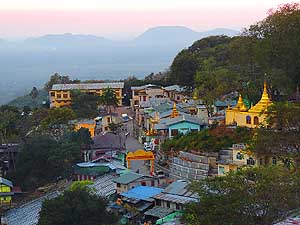
|
-
-
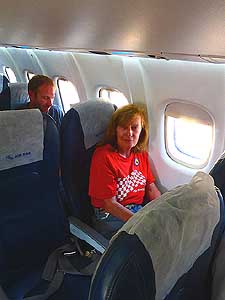
|
-
-
-
-
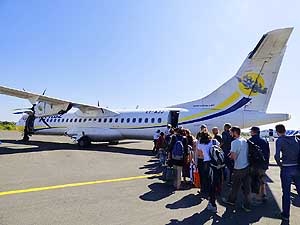
|
-
358 At the foot of the Mount Popa outcrop
- snuggles the same named village which
- spreads an atmosphere of calmness and peace
|
-
359 The visa of our 28 day Myanmar
- trip is coming
to an end. Liliana is sitting
- sadly in the airplane of Air KBZ that
brings
- us now from Nyaung-U (Bagan) to Yangon.
- One day later we fly with Air Asia back to
- Kuala Lumpur in Malaysia
|
-
360 The airplane is after
bus, railway,
- boat and shared taxi our last Myanmese
- (Burmese) mean of
transport with which
- we crisscrossed for one month Myanmar.
- We are
boarding it in Nyaung-U with
- destination Yangon (Rangoon)
|
-
|
-
More websites from Myanmar:
- Myanmar (Burma) Part
1 – from Yangon (Rangoon) to the 'Golden Rock' of
Kyaiktiyo
- Myanmar (Burma) Part
2 – Bago (Pegu) - Shwenyaung
at Inle Lake
- Myanmar (Burma) Part 3 – from Nyaungshwe at Inle Lake to Mandalay and Goteik viaduct
|
- The African trip
2013-16:
- CapeVerde: Santiago/Praia
part 1 – November18th to December 13th, 2013
- CapeVerde: Fogo
– Dezember13th to 23rd, 2013
- CapeVerde: Brava
– December 23rd to 26th, 2013
- Cape Verde: Santiago/Praia
part 2 – December 26th, 2013 to February 28th, 2014
- Cape Verde: São Nicolau – February
28th to March 13th, 2014
- Cape Verde: São Vicente/Mindelo part 1
– March 13th to 20th, 2014
- Cape
Verde: Santo Antão/Eastern side part 1 –
March 20th to April 7th, 2014
- Cape
Verde: Santo Antão/Western side part 2 –
April 7th to 10th, 2014
- Cape
Verde: São Vicente/Mindelo part 2 –
April 10th to 29th, 2014
-
Namibia Part 1 –
from Walvis Bay to Windhoek
- Angola Part 1
–
September 26th to October 4th, 2014
- Angola Part 2 –
October 4th to 22nd, 2014
-
Namibia Part 2 –
from Windhoek to the Angolan border, back again and on to
South Africa
-
South Africa
Part 1 –
from Namibia border to Capetown –
January 22nd to February 23rd, 2015
- 3rd Major Repair of our
LandCruiser FJ60 - 1982 (due to two broken sideshafts)
-
South Africa
Part 2 – from Capetown to Tsitsikamma
National Park – February 24th to March 13th, 2015
- South Africa
Part 3 – from Addo National Park to
the Lesotho border –
March 13th to April 7th, 2015
-
Lesotho –
April 7th to 15th, 2015
-
South Africa Part 4
– from the Lesotho
to the Swaziland border – April 15th to 23rd, 2015
-
Swaziland – April 23rd to 28th,
2015
-
South Africa Part 5
– from the Swaziland to the Botswana border
– April 28th to May 15th, 2015
-
Botswana
-
Zimbabwe
-
Mozambique
-
Malawi
-
Armed Robbery in Malawi on July
31st/August 1st, 2015
-
Tanzania
-
Kenya
-
Ethiopia Part 1 – from Kenya to
Djibouti –
October 25th to November 18th, 2015
-
Djibouti –
October 18th to 27th, 2015
-
Ethiopia Part 2 –
from
Djibouti to
Sudan
– November 27th to December
9th, 2015
- Sudan –
December 9th, 2015 to January 8th, 2016
|
![]()
